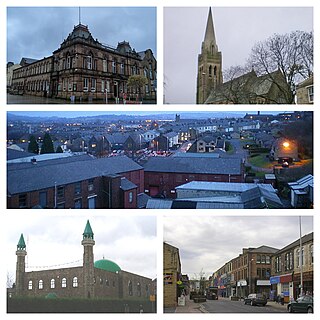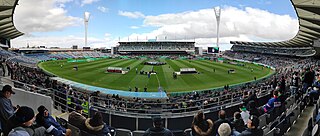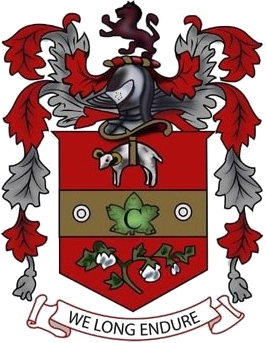Related Research Articles

Tannadice Park, usually referred to as Tannadice, is a football stadium in Dundee, Scotland. It is the home ground of Dundee United F.C., who have played at Tannadice since the club was founded as Dundee Hibernian in 1909. The stadium has been all-seated since 1994 and has a capacity of 14,223. It is located only 200 yards from Dundee F.C.'s stadium, Dens Park; the two are the closest senior football grounds in the UK.

Nelson is a town and civil parish in the Borough of Pendle in Lancashire, England, with a population of 29,135 in 2011. It is 4 miles (6.4 km) north of Burnley and 2.5 miles southwest of Colne.

Kardinia Park is a sporting and entertainment venue located within Kardinia Park, South Geelong, in the Australian state of Victoria. The stadium, which is owned and operated by the Kardinia Park Stadium Trust, is the home ground of AFL club Geelong Football Club and A-League club Western United. The capacity of Kardinia Park is 36,000, making it the largest-capacity Australian stadium in a regional city.
The Lancashire League is a competitive league of local cricket clubs drawn from the small to middle-sized mill towns, mainly but not exclusively, of East Lancashire. Its real importance is probably due to its history of employing professional players of international standing to play in the League.

Ewood Park is a football stadium in Blackburn, Lancashire, England, and the home of Blackburn Rovers F.C., founding members of the Football League and Premier League, who have played there since 1890. It is an all seater multi-sports facility with a capacity of 31,367, and four sections: the Bryan Douglas Darwen End, Riverside Stand, Ronnie Clayton Blackburn End, and Jack Walker Stand, named after Blackburn industrialist and club supporter, Jack Walker. The football pitch within the stadium measures 115 by 76 yards

Nelson Football Club is a football club based in Nelson, Lancashire, England. Originally established in 1882, the club played in the Lancashire League, North-East Lancashire Combination, Lancashire Combination and Central League before becoming founder members of the Third Division North of the Football League in 1921. They were Division Three North champions in 1922–23 and were promoted to the Second Division. However, they were relegated back to the Third Division North after a single season.

The Shay is a sports stadium in Halifax, West Yorkshire, England.

Turf Moor is an association football stadium in Burnley, Lancashire, England, which has been the home of Burnley F.C. since 1883. This unbroken service makes Turf Moor the second-longest continuously used ground in English professional football. The stadium is situated on Harry Potts Way, named after the manager who won the 1959–60 First Division with the club, and has a capacity of 21,944.

Colne Dynamoes Football Club was a football club based in Colne, Lancashire, England. After spending much of their existence in the lower reaches of Non-League football, heavy financial investment by former player turned millionaire chairman-manager, Graham White, saw the club rise rapidly through the leagues in the late 1980s. However, upon winning the Northern Premier League championship in 1989–90, the club were refused promotion to the Football Conference having failed to meet ground grading conditions and were dissolved by White in the summer of 1990.

The Pilot Field is a football stadium in Hastings, East Sussex. It is home to Hastings United who currently play in the Isthmian League, the club have used the ground since 1985 after the old Hastings United folded, having previously used the ground between 1920 and 1948. The current capacity stands at 4,050 although over 9,000 have been known to attend events in the past and the closure of the grass bank has decreased the capacity.

Saltergate, officially the Recreation Ground, was the historic home of Chesterfield Football Club, and was in use from 1871 until the club's relocation in July 2010, a 139-year history that made it one of the oldest football grounds in England at the time of its closure. From the 1920s onward the name 'Saltergate' became predominant in popular references to the ground.

Arden Street Oval is a sports oval in North Melbourne, Victoria. It is currently the training base of the North Melbourne Football Club, an Australian rules football club, and up to the end of the 1985 season it was used as the team's home ground for Victorian Football League (VFL) matches.

Knowsley Road in Eccleston, St Helens, Merseyside, was the home ground of St. Helens from 1890 until its closure in 2010. St Helens Town FC played their home fixtures at Knowsley Road from 2002 until 2010. For a period, the venue also hosted Liverpool F.C. Reserves. The stadium was demolished during spring 2011 and a new construction then known as Cunningham Grange, named after club legend Keiron Cunningham, was built on the site.

The Seedhill Cricket Ground is a small cricket stadium in the English town of Nelson, Lancashire. It is the home of Lancashire League cricket team Nelson Cricket Club. It is situated near to Seedhill Football Ground, the former home of North West Counties League Division One side Nelson F.C. and its home during its period in the Football League from 1921 to 1931, during which time it won the Third Division North title in 1922-23 and played in the then Second Division the following season.

Highbury Stadium is a football stadium in Fleetwood, Lancashire, England with Wyre Borough Council as the landlords. It is the home ground of Fleetwood Town and was also used for home matches by Blackpool F.C. reserves until 2014. As of the opening of the new Parkside Stand on 16 April 2011, the ground has a capacity of 5,327. Highbury Stadium is currently the 114th largest stadium by capacity in England and the twenty third in their league.

North Marine Road Ground, formerly known as Queen's, is a cricket ground in Scarborough, North Yorkshire, England. It is the home of Scarborough Cricket Club which hosts the Scarborough Festival and the Yorkshire County Cricket Club plays a series of fixtures in the second half of the season each year. The current capacity is 11,500, while its record attendance is the 22,946 who watched Yorkshire play Derbyshire in 1947. The two ‘ends’ are known as the Peasholm Park End and the Trafalgar Square End.
Edmund Eastwood was an English professional association footballer who played as a full-back.
The 1921–22 season was the 41st season of football played by Nelson. It was their first season as a professional club, and their first in the Football League Third Division North, after the restructuring of the English league system. The side ended the season in 16th place in the division, finishing behind Barrow on goal average. The campaign started on 27 August 1921 with a 1–2 defeat by Wigan Borough, which was attended by a then record crowd of 9,000 at Seedhill. Nelson's first win in the Football League came on 3 September 1921, when they beat Wigan Borough 4–1 at Springfield Park. The season ended with a 0–0 draw at home to Tranmere Rovers on 6 May 1922. By the end of the campaign, the side had a league record of 13 wins, seven draws and 18 defeats, giving them a total of 33 points.
Burnley Greyhound Stadium also known as Towneley Stadium was a former greyhound racing and speedway stadium in Burnley, Lancashire.
Clitheroe Cricket Club is a cricket club which plays its home games at the Clitheroe Cricket Bowling & Tennis Club ground on Chatburn Road in Clitheroe, Lancashire, England. From 2017, it plays in the Lancashire League, having resigned the Ribblesdale League at the end of the 2016 season.
References
- 1 2 "Nelson FC poised for return to historic home". This Is Lancashire. 30 April 2009. Retrieved 14 February 2010.
- ↑ "Fire in Football Pavilion". British Newspaper Archive. The Leader, 11 November 1932. Retrieved 11 June 2018.
- ↑ "All-Time Football League Second Flight Table from 1892-93 to 2014-15". MyFootballFacts.com. Retrieved 16 June 2018.
- ↑ "Nelson Club Information". Nelson F.C. Retrieved 14 February 2010.
- ↑ "Nelson Speedway". Defunct Speedway. Retrieved 14 February 2010.